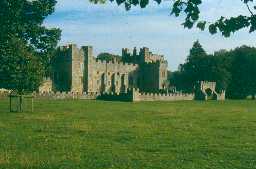Local History
Featherstone (Northumberland)
Featherstone lies in south-west Northumberland on the edge of the North Pennine hills, close to the border with Cumbria. The landscape is varied, ranging from the moorland of Featherstone and Broomhouse Commons to the wooded valley of the River South Tyne. Featherstone Castle and its parkland lie at the centre of the parish with small villages and outlying farms along the valley sides.
Little is known about the parish in early prehistoric times. There have been no discoveries of prehistoric stone tools and the first evidence of human activity belongs to the Bronze Age. A quite unusual discovery made in the 19th century was the uncovering of more than eight tree trunk coffins preserved in a boggy field near Wydon Eals.
The remains of two quite different types of settlement are known from the Iron Age or Roman periods. One is a small enclosed farm on the southern slopes of the South Tyne valley and the other is an unenclosed settlement on the gravel river terrace. A burial was also found on the river terrace, unusually, placed inside one of the round houses. Featherstone lies south of Hadrian's Wall and the course of Maiden Way Roman road runs through the western side of the parish on its way between the forts at Whitley Castle and Carvoran.
Following the end of Roman rule in Britain in the early fifth century, there is no evidence of any settlement in the parish until after the Norman Conquest. In medieval times two small villages are known at Featherstone and Wydon and a manorial settlement at Bellister. The area suffered from a period of warfare and many raids from Scotland. It was because of this that a number of fortified tower houses were built, including one at Featherstone Castle and Bellister Castle. Both these castles have earlier origins as medieval hall houses.
The post-medieval period saw the beginning of more peaceful times and was a relatively prosperous time for the border region of England. The development of Bellister and Featherstone castles at this time was more in keeping with a country house and reflects the growing security and confidence of the region. This also extended to the laying out of parkland at Featherstone. Many of the buildings in Park Village were also built at this time. Farming has played an important part in the economic life of the parish and in the late 18th century, when improvements to agricultural systems were at their height, and in the years that followed, a number of new farms were built here, such as Lynnshield, Broomhouse and Wydon Eals. A number of industries developed alongside farming, such as millstone quarrying at Wydon Eals and Watch Law/Brockholm. Spiritually, the people of Featherstone appear to have adopted Wesleyan Methodism represented here by the chapel at Park Village. More recently, Featherstone Park was the location of a Prisoner of War Camp after World War II. Today, the parish offers pleasant walks along the valley of the South Tyne and the higher moorland of the commons.
Little is known about the parish in early prehistoric times. There have been no discoveries of prehistoric stone tools and the first evidence of human activity belongs to the Bronze Age. A quite unusual discovery made in the 19th century was the uncovering of more than eight tree trunk coffins preserved in a boggy field near Wydon Eals.
The remains of two quite different types of settlement are known from the Iron Age or Roman periods. One is a small enclosed farm on the southern slopes of the South Tyne valley and the other is an unenclosed settlement on the gravel river terrace. A burial was also found on the river terrace, unusually, placed inside one of the round houses. Featherstone lies south of Hadrian's Wall and the course of Maiden Way Roman road runs through the western side of the parish on its way between the forts at Whitley Castle and Carvoran.
Following the end of Roman rule in Britain in the early fifth century, there is no evidence of any settlement in the parish until after the Norman Conquest. In medieval times two small villages are known at Featherstone and Wydon and a manorial settlement at Bellister. The area suffered from a period of warfare and many raids from Scotland. It was because of this that a number of fortified tower houses were built, including one at Featherstone Castle and Bellister Castle. Both these castles have earlier origins as medieval hall houses.
The post-medieval period saw the beginning of more peaceful times and was a relatively prosperous time for the border region of England. The development of Bellister and Featherstone castles at this time was more in keeping with a country house and reflects the growing security and confidence of the region. This also extended to the laying out of parkland at Featherstone. Many of the buildings in Park Village were also built at this time. Farming has played an important part in the economic life of the parish and in the late 18th century, when improvements to agricultural systems were at their height, and in the years that followed, a number of new farms were built here, such as Lynnshield, Broomhouse and Wydon Eals. A number of industries developed alongside farming, such as millstone quarrying at Wydon Eals and Watch Law/Brockholm. Spiritually, the people of Featherstone appear to have adopted Wesleyan Methodism represented here by the chapel at Park Village. More recently, Featherstone Park was the location of a Prisoner of War Camp after World War II. Today, the parish offers pleasant walks along the valley of the South Tyne and the higher moorland of the commons.
N13254
UNCERTAIN
Disclaimer -
Please note that this information has been compiled from a number of different sources. Durham County Council and Northumberland County Council can accept no responsibility for any inaccuracy contained therein. If you wish to use/copy any of the images, please ensure that you read the Copyright information provided.
